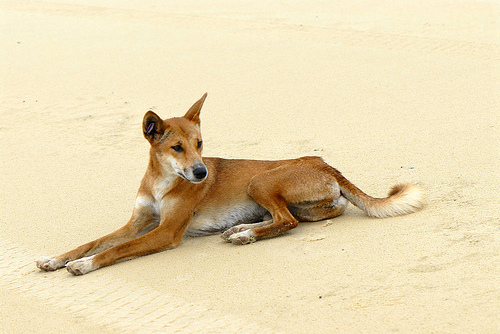It doesn’t get wilder than a dingo!
- Dingoes are a wild dog species native to grassy and desert habitats of Australia, and they also exist in parts of South East Asia.
- The scientific name of a dingo is Canis lupus dingo and it is from the family Canidae, the family of dogs.
- ‘Dingoes’ are also known as ‘Australian wolves’ and ‘Australian native dogs’, and there are many local native names for them as well.
- The length of the body of a dingo typically ranges from 86 to 123 centimetres (34 to 48 inches), while the height to the shoulder is usually 44 to 67 centimetres (17 to 26 inches), and its weight ranges from 9.6 to 20 kilograms (21 to 44 pounds).
- Dingoes typically have fur of a brown colour, from sandy to orange and reddish shades, often with white feet and a lighter coloured muzzle and belly, and they can also have black markings, or be fully black.
A Dingo
Image courtesy of Sam Fraser-Smith/Flickr
- The dingo’s diet consists mostly of possums, red kangaroos, wallabies, wombats, rabbits, rats, magpie geese, young cattle and sheep.
- Dingoes are generally territorial and sometimes live by themselves, though they can form packs of three to twelve, especially to hunt large animals; and they have a lifespan of 7 to 15 years.
- Dingoes are generally considered problematic in the livestock industry, because of their attacks on farm animals, and this led to a dingo fence being erected across southeast Australia in the late 1800s and early 1900s, to protect livestock in many areas; while shooting, trapping and poisoning have also been methods to reduce numbers of the wild dogs in problem areas.
- Roughly 65% of a dingo’s communication is a form of growling; while howling is also common, and barking occurs occasionally.
- Dingoes are listed as vulnerable and are protected in a number of areas in Australia, and they are listed as such as their numbers are decreasing due in part to interbreeding with domestic dogs.
Bibliography:
Burrel S, Dingo, 2015, Australian Museum, http://australianmuseum.net.au/dingo
Hintze M, Canis Lupus Dingo, 2002, Animal Diversity Web, http://animaldiversity.org/accounts/Canis_lupus_dingo/
Dingo, 2016, A-Z Animals, http://a-z-animals.com/animals/dingo/
Dingo, 2016, Wikipedia, https://en.wikipedia.org/wiki/Dingo








